First U-Pb (CA-ID-TIMS) Dating of the Uppermost Permian Coal Interval in the Minusinsk Coal Basin (Siberia, Russia) Using Zircon Grains from Volcanic Ashfalls
Abstract
1. Introduction
2. Geological Background
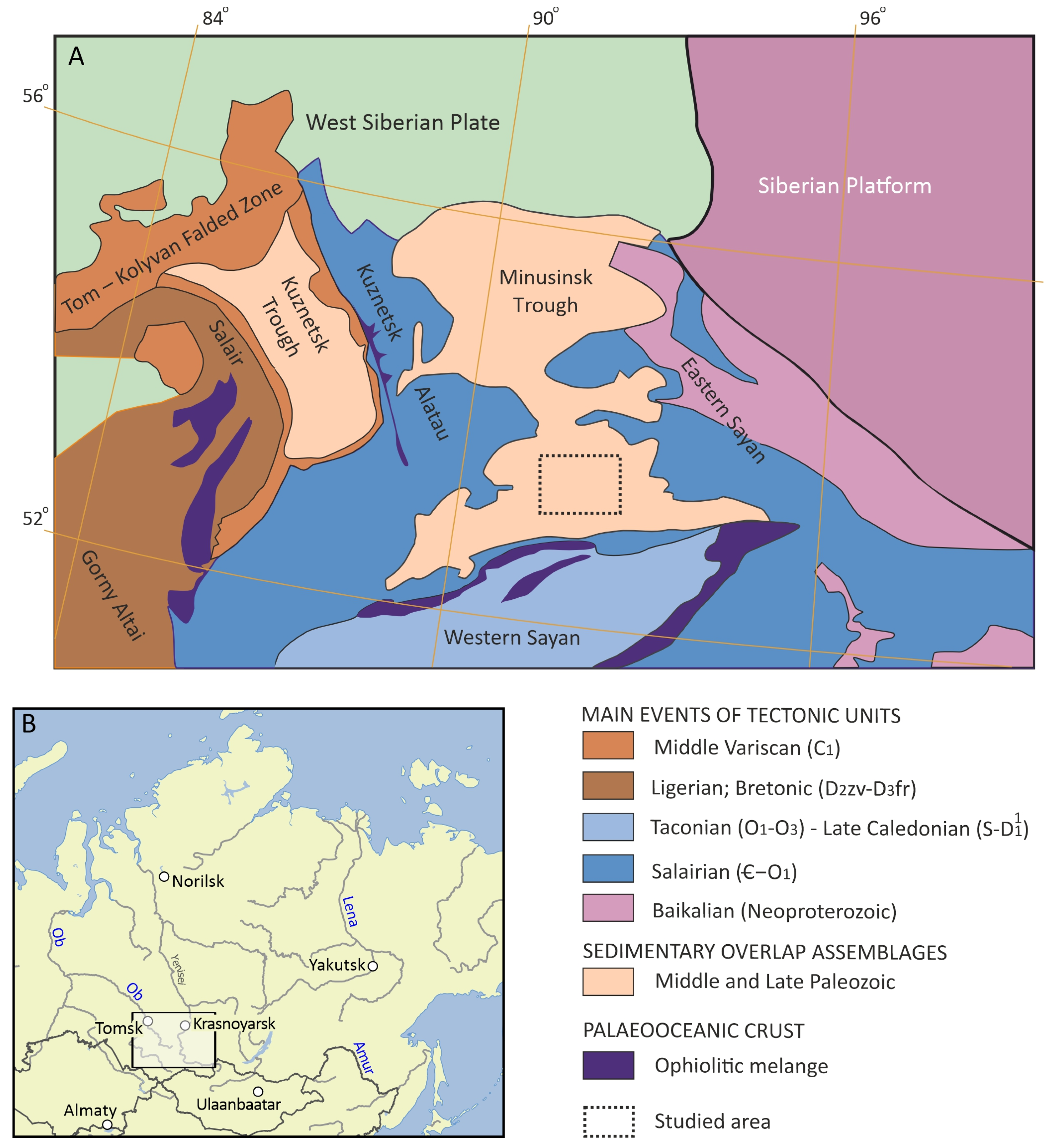
3. Materials
4. Methods
5. Results
6. Discussion
7. Conclusions
Supplementary Materials
Author Contributions
Funding
Data Availability Statement
Acknowledgments
Conflicts of Interest
References
- Schmitz, M.D.; Singer, B.S.; Rooney, A.D. Radioisotope Geochronology. In Geologic Time Scale 2020; Gradstein, F.M., Ogg, J.G., Schmitz, M.D., Ogg, G.M., Eds.; Elsevier: Amsterdam, The Netherlands, 2020; Volume 1, pp. 193–209. [Google Scholar] [CrossRef]
- Wang, T.; Ramezani, J.; Yang, C.; Yang, J.; Wu, Q.; Zhang, Z.; Lv, D.; Wang, C. High-resolution geochronology of sedimentary strata by U-Pb CA-ID-TIMS zircon geochronology: A review. Earth-Sci. Rev. 2023, 245, 104550. [Google Scholar] [CrossRef]
- Spears, D.A. A kaolinite mudstone (tonstein) in the British Coal Measures. J. Sedim. Petrol. 1970, 40, 386–394. [Google Scholar] [CrossRef]
- Spears, D.A. The origin of tonsteins, an overview, and links with seatearths, fireclays and fragmental clay rocks. Int. J. Coal Geol. 2012, 94, 22–31. [Google Scholar] [CrossRef]
- Spears, D.A.; Arbuzov, S.I. A geochemical and mineralogical update on two major tonsteins in the UK Carboniferous Coal Measures. Int. J. Coal Geol. 2019, 210, 103199. [Google Scholar] [CrossRef]
- Lyons, P.C.; Spears, D.A.; Outerbridge, W.F.; Congdon, R.D.; Evans, H.T. Euramerican tonsteins: Overview, magmatic origin, and depositional-tectonic implications. Palaeogeogr. Palaeoclimatol. Palaeoecol. 1994, 106, 113–134. [Google Scholar] [CrossRef]
- Opluštil, S.; Laurin, J.; Hýlová, L.; Jirásek, J.; Schmitz, M.; Sivek, M. Coal-bearing fluvial cycles of the late Paleozoic tropics; astronomical control on sediment supply constrained by high-precision radioisotopic ages, Upper Silesian Basin. Earth-Sci. Rev. 2022, 228, 103998. [Google Scholar] [CrossRef]
- Shen, M.; Dai, S.; Graham, I.T.; Nechaev, V.P.; French, D.; Zhao, F.; Shao, L.; Liu, S.; Zuo, J.; Zhao, J.; et al. Mineralogical and geochemical characteristics of altered volcanic ashes (tonsteins and K-bentonites) from the latest Permian coal-bearing strata of western Guizhou Province, southwestern China. Int. J. Coal Geol. 2021, 237, 103707. [Google Scholar] [CrossRef]
- Shen, M.; Dai, S.; Nechaev, V.P.; French, D.; Graham, I.T.; Liu, S.; Chekryzhov, I.Y.; Tarasenko, I.A.; Zhang, S. Provenance changes for mineral matter in the latest Permian coals from western Guizhou, southwestern China, relative to tectonic and volcanic activity in the Emeishan Large Igneous Province and Paleo-Tethys region. Gondwana Res. 2023, 113, 71–88. [Google Scholar] [CrossRef]
- Lyons, P.C.; Krogh, T.E.; Kwok, Y.Y.; Davis, D.W.; Outerbridge, W.F.; Evans, H.T. Radiometric ages of the Fire Clay tonstein [Pennsylvanian (Upper Carboniferous), Westphalian, Duckmantian]: A comparison of U-Pb zircon single-crystal ages and 40Ar/39Ar sanidine single-crystal plateau ages. Int. J. Coal Geol. 2006, 67, 259–266. [Google Scholar] [CrossRef]
- Ducassou, C.; Mercuzot, M.; Bourquin, S.; Rossignol, C.; Pellenard, P.; Beccaletto, L.; Poujol, M.; Hallot, E.; Pierson-Wickmann, A.C.; Hue, C.; et al. Sedimentology and U-Pb dating of Carboniferous to Permian continental series of the northern Massif Central (France): Local palaeogeographic evolution and larger scale correlations. Palaeogeogr. Palaeoclimatol. Palaeoecol. 2019, 533, 109228. [Google Scholar] [CrossRef]
- Jirásek, J.; Opluštil, S.; Sivek, M.; Schmitz, M.D.; Abels, H.A. Astronomical forcing of Carboniferous paralic sedimentary cycles in the Upper Silesian Basin, Czech Republic (Serpukhovian, latest Mississippian): New radiometric ages afford an astronomical age model for European biozonations and substages. Earth-Sci. Rev. 2018, 177, 715–741. [Google Scholar] [CrossRef]
- Opluštil, S.; Schmitz, M.; Cleal, C.J.; Martínek, K. A review of the Middle–Late Pennsylvanian west European regional substages and floral biozones, and their correlation to the Geological Time Scale based on new U–Pb ages. Earth-Sci. Rev. 2016, 154, 301–335. [Google Scholar] [CrossRef]
- Pellenard, P.; Gand, G.; Schmitz, M.; Galtier, J.; Broutin, J.; Stéyer, J.S. High-precision U-Pb zircon ages for explosive volcanism calibrating the NW European continental Autunian stratotype. Gondwana Res. 2017, 51, 118–136. [Google Scholar] [CrossRef]
- Davydov, V.I.; Crowley, J.L.; Schmitz, M.D.; Poletaev, V.I. High-Precision U-Pb Zircon Age Calibration of the Global Carboniferous Time Scale and Milankovitch Band Cyclicity in the Donets Basin, Eastern Ukraine. Geochem. Geophys. Geosystems 2010, 11, Q0AA04. [Google Scholar] [CrossRef]
- Davydov, V.I.; Korn, D.; Schmitz, M.D. The Carboniferous period. In The Geologic Time Scale, 1st ed.; Gradstein, F.M., Ogg, J.G., Schmitz, M., Ogg, G., Eds.; Elsevier: Oxford, UK, 2012; pp. 603–651. [Google Scholar] [CrossRef]
- Metcalfe, I.; Crowley, J.L.; Nicoll, R.S.; Schmitz, M. High-precision U-Pb CA-TIMS calibration of Middle Permian to Lower Triassic sequences, mass extinction and extreme climate-change in eastern Australian Gondwana. Gondwana Res. 2015, 28, 61–81. [Google Scholar] [CrossRef]
- Shi, G.R.; Nutman, A.P.; Lee, S.; Jones, B.G.; Bann, G.R. Reassessing the chronostratigraphy and tempo of climate change in the Lower-Middle Permian of the southern Sydney Basin, Australia: Integrating evidence from U–Pb zircon geochronology and biostratigraphy. Lithos 2022, 410–411, 106570. [Google Scholar] [CrossRef]
- Sobczak, K.; Cooling, J.; Crossingham, T.; Holl, H.G.; Reilly, M.; Esterle, J.; Crowley, J.L.; Hannaford, C.; Mohr, M.T.; Hamerli, Z.; et al. Palynostratigraphy and Bayesian age stratigraphic model of new CA-ID-TIMS zircon ages from the Walloon Coal Measures, Surat Basin, Australia. Gondwana Res. 2024, 132, 150–167. [Google Scholar] [CrossRef]
- Cagliari, J.; Schmitz, M.D.; Tedesco, J.; Trentin, F.A.; Lavina, E.L.C. High-precision U-Pb geochronology and Bayesian age-depth modelling of the glacial-postglacial transition of the southern Paraná Basin: Detailing the terminal phase of the Late Paleozoic Ice Age on Gondwana. Sediment. Geol. 2023, 451, 106397. [Google Scholar] [CrossRef]
- Cagliari, J.; Lavina, E.L.C.; Philipp, R.P.; Tognoli, F.M.W.; Basei, M.A.S.; Faccini, U.F. New Sakmarian ages for the Rio Bonito formation (Paraná Basin, southern Brazil) based on LA-ICP-MS U-Pb radiometric dating of zircons crystals. J. S. Am. Earth Sci. 2014, 56, 265–277. [Google Scholar] [CrossRef]
- Guerra-Sommer, M.; Cazzulo-Klepzig, M.; Santos, J.O.S.; Hartmann, L.A.; Ketzer, J.M.; Formoso, M.L.L. Radiometric age determination of tonsteins and stratigraphic constraints for the Lower Permian coal succession in southern Paraná Basin, Brazil. Int. J. Coal Geol. 2008, 74, 13–27. [Google Scholar] [CrossRef]
- Jurigan, I.; Ricardi-Branco, F.; Neregato, R.; dos Santos, T.J.S. A new tonstein occurrence in the eastern Paraná Basin associated with the Figueira coalfield (Paraná, Brazil): Palynostratigraphy and U-Pb radiometric dating integration. J. S. Am. Earth Sci. 2019, 96, 102377. [Google Scholar] [CrossRef]
- Mori, A.L.O.; de Souza, P.A.; Marques, J.C.; da Cunha Lopes, R. A new U-Pb zircon age dating and palynological data from a Lower Permian section of the southernmost Paraná Basin, Brazil: Biochronostratigraphical and geochronological implications for Gondwanan correlations. Gondwana Res. 2012, 21, 654–669. [Google Scholar] [CrossRef]
- Simas, M.W.; Guerra-Sommer, M.; Cazzulo-Klepzig, M.; Menegat, R.; Schneider Santos, J.O.; Fonseca Ferreira, J.A.; Degani-Schmidt, I. Geochronological correlation of the main coal interval in Brazilian Lower Permian: Radiometric dating of tonstein and calibration of biostratigraphic framework. J. S. Am. Earth Sci. 2012, 39, 1–15. [Google Scholar] [CrossRef]
- Feng, Y.; Yang, T.; Liang, F.; Liu, F.; Sun, G. New zircon U–Pb age of the Didao Formation in Jixi Basin and its significance for the geology and paleogeography in Jixi and eastern Heilongjiang region in the Early Cretaceous. Cretac. Res. 2022, 135, 105169. [Google Scholar] [CrossRef]
- Wang, J.; Shao, L.Y.; Wang, H.; Spiro, B.; Large, D. SHRIMP zircon U–Pb ages from coal beds across the Permian–Triassic boundary, eastern Yunnan, southwestern China. J. Palaeogeogr. 2018, 7, 117–129. [Google Scholar] [CrossRef]
- Zhang, Z.; Lv, D.; Hower, J.C.; Wang, L.; Shen, Y.; Zhang, A.; Xu, J.; Gao, J. Geochronology, mineralogy, and geochemistry of tonsteins from the Pennsylvanian Taiyuan Formation of the Jungar Coalfield, Ordos Basin, North China. Int. J. Coal Geol. 2023, 267, 104183. [Google Scholar] [CrossRef]
- Mikheeva, E.A.; Demonterova, E.I.; Khubanov, V.B.; Ivanov, A.V.; Arzhannikova, A.V.; Arzhannikov, S.G.; Blinov, A.V. Age of the coal accumulation in the irkutsk basin based on accessory zircon dating in the azeisk deposit tonstein (LA-ICP-MS). Vestn. St. Petersburg Univ. Earth Sci. 2020, 65, 420–433. [Google Scholar] [CrossRef]
- Davydov, V.I.; Karasev, E.V.; Nurgalieva, N.G.; Schmitz, M.D.; Budnikov, I.V.; Biakov, A.S.; Kuzina, D.M.; Silantiev, V.V.; Urazaeva, M.N.; Zharinova, V.V.; et al. Climate and biotic evolution during the Permian-Triassic transition in the temperate Northern Hemisphere, Kuznetsk Basin, Siberia, Russia. Palaeogeogr. Palaeoclimatol. Palaeoecol. 2021, 573, 110432. [Google Scholar] [CrossRef]
- Silantiev, V.V.; Gutak, Y.M.; Tichomirowa, M.; Kulikova, A.V.; Felker, A.S.; Urazaeva, M.N.; Porokhovnichenko, L.G.; Karasev, E.V.; Bakaev, A.S.; Zharinova, V.V.; et al. First radiometric dating of tonsteins from coal-bearing succession of the Kuznetsk Basin: U-Pb geochronology of the Tailugan Formation. Georesursy=Georesources 2023, 25, 203–227. [Google Scholar] [CrossRef]
- Silantiev, V.V.; Gutak, Y.M.; Tichomirowa, M.; Käßner, A.; Kutygin, R.V.; Porokhovnichenko, L.G.; Karasev, E.V.; Felker, A.S.; Bakaev, A.S.; Naumcheva, M.A.; et al. U-Pb Dating of the Kolchugino Group Basement (Kuznetsk Coal Basin, Siberia): Was the Change in Early–Middle Permian Floras Simultaneous at Different Latitudes in Angaraland? Geosciences 2024, 14, 21. [Google Scholar] [CrossRef]
- Admakin, L.A. Types of tonsteins in coal beds of Minusinsk basin. Lithol. Min. Res. 1992, 2, 49–56. (In Russian) [Google Scholar]
- Arbuzov, S.I.; Ershov, V.V.; Rikhvanov, L.P.; Kyargin, V.V.; Bulatov, A.A.; Dubovik, P.E. Rare-Metal Potential of Coals of Minusinsk Basin; Publishing House SO RAN Branch “GEO”: Novosibirsk, Russia, 2003; 347p. (In Russian) [Google Scholar]
- Arbuzov, S.I.; Ilenok, S.S.; Vergunov, A.V.; Shaldybin, M.V.; Sobolenko, V.M.; Nekrasov, P.E. Mineralogical-geochemical identification of explosive volcanism products in coals of the Minusinsk basin. In Petrology of Magmatic and Metamorphic Complexes. Issue 9, Proceedings of 9th All-Russian Petrographic Conference; CSTI: Tomsk, Russia, 2017; pp. 35–37. (In Russian) [Google Scholar]
- Vergunov, A.V.; Arbuzov, S.I.; Sobolenko, V.M. Mineralogy and geochemistry of the tonsteins in the coals of the Beisk deposit of Minusinsk Basin. Bull. Tomsk Polytech. Univ. Geo Assets Eng. 2019, 330, 155–166, (In Russian with English Abstract). [Google Scholar] [CrossRef]
- Vergunov, A.V.; Arbuzov, S.I.; Eremeyeva, V.V. Mineralogy, geochemistry and genesis of rare-metal Zr-Nb-Hf-Ta-REE-Ga mineralization in bed XXX of Minusinsk Basin. Bull. Tomsk Polytech. Univ. Geo Assets Eng. 2020, 331, 49–62, (In Russian with English Abstract). [Google Scholar] [CrossRef]
- Vergunov, A.V.; Arbuzov, S.I.; Spears, D.A.; Kholodov, A.S.; Ilenok, S.S. Mineralogy and geochemistry of rare metal (Zr-Nb-Hf-Ta-REE-Ga) coals of the seam XXX of the Izykh Coalfield, Minusinsk Basin, Russia: Implications for more widespread rare metal mineralization in North Asia. Int. J. Coal Geol. 2024, 289, 104542. [Google Scholar] [CrossRef]
- Hower, J.C.; Rupport, L.F.; Cortland, F.E. Lanthanide, yttrium, and zirconium anomalies in the Fire Clay coal bed, Eastern Kentucky. Int. J. Coal Geol. 1999, 39, 141–153. [Google Scholar] [CrossRef]
- Dai, S.; Zhou, Y.; Zhang, M.; Wan, G.X.; Wang, J.; Song, X.; Jiang, Y.; Luo, Y.; Song, Z.; Yang, Z.; et al. A new type of Nb (Ta)-Zr(Hf)-REE-Ga polymetallic deposit in the late Permian coal-bearing strata, eastern Yunnan, southwestern China: Possible economic significance and genetic implications. Int. J. Coal Geol. 2010, 83, 55–63. [Google Scholar] [CrossRef]
- Dai, S.; Ward, C.R.; Graham, I.T.; French, D.; Hower, J.C.; Zhao, L.; Wang, X. Altered volcanic ashes in coal and coal-bearing sequences: A review of their nature and significance. Earth-Sci. Rev. 2017, 175, 44–74. [Google Scholar] [CrossRef]
- Dai, S.; Nechaev, V.P.; Chekryzhov, I.Y.; Zhao, L.; Vysotskiy, S.V.; Graham, I.; Ward, C.R.; Ignatiev, A.V.; Velivetskaya, T.A.; Zhao, L. A model for Nb–Zr–REE–Ga enrichment in Lopingian altered alkaline volcanic ashes: Key evidence of H-O isotopes. Lithos 2018, 302–303, 359–369. [Google Scholar] [CrossRef]
- Arbuzov, S.I.; Spears, D.A.; Vergunov, A.V.; Ilenok, S.S.; Mezhibor, A.M.; Ivanov, V.P.; Zarubina, N.A. Geochemistry, mineralogy and genesis of rare metal (Nb-Ta-Zr-Hf-Y-REE-Ga) coals of the seam XI in the south of Kuznetsk Basin, Russia. Ore Geol. Rev. 2019, 113, 103073. [Google Scholar] [CrossRef]
- Sivtchikov, V.E.; Donova, N.B. Stratigraphic subdivision of the Upper Palaeozoic deposits of the South Minusinsk Depression. Lethaea Ross. Russ. Palaeobot. J. 2016, 13, 1–46. [Google Scholar]
- Neiburg, M.F. Stratigraphic comparison of coal-bearing strata of the Minusinsk and Kuznetsk basins in Siberia. In Proceedings Devoted to Academician V.I. Obruchev; Publishing House of the USSR Academy of Sciences: Moscow, Russia, 1938; Volume 1, pp. 27–40. (In Russian) [Google Scholar]
- Radchenko, G.P. Guiding forms of the Upper Paleozoic flora of the Altai-Sayan region. In Atlas of Guiding Forms of Fossil Flora and Fauna of Western Siberia, Part II; Khalfin, L.L., Ed.; Gosgeoltekhizdat: Moscow, Russia, 1955; pp. 42–154. (In Russian) [Google Scholar]
- Spasskaya, I.S. On the assemblages of bivalve molluscs of coal-bearing strata of the Izykh field in the Minusinsk coal basin. In Continental Upper Paleozoic and Mesozoic of Siberia and Central Kazakhstan: Biostratigraphy and Palaeontology; Nalivkin, D.V., Ed.; Nauka: Moscow-Leningrad, Russia, 1966; pp. 5–40. (In Russian) [Google Scholar]
- Gorelova, S.G. Phytostratigraphic characterisation of coal-bearing strata of the Minusinsk basin. In Coal-Bearing Strata of the Kuznetsk and Tunguska Provinces; Zvonarev, I.N., Ed.; Proceedings of the SNIIGGiMS, 221; SNIIGGiMS: Novosibirsk, Russia, 1975; pp. 47–56. (In Russian) [Google Scholar]
- Dryagina, L.L. Palynological assemblages of coal seams of the Izykh deposit of the Minusinsk basin. In Coal-Bearing Strata of the Kuznetsk and Tunguska Provinces; Zvonarev, I.N., Ed.; Proceedings of the SNIIGGiMS, 221; SNIIGGiMS: Novosibirsk, Russia, 1975; pp. 57–58. (In Russian) [Google Scholar]
- Troshkova, G.N.; Zhichko, L.A. Coal-bearing strata of the Minusinsk basin. In Stratigraphy of the Palaeozoic of Middle Siberia; Sokolov, B.S., Ed.; Nauka: Novosibirsk, Russia, 1967; pp. 186–189. (In Russian) [Google Scholar]
- Betekhtina, O.A.; Gorelova, S.G.; Dryagina, L.L.; Danilov, V.I.; Batyaeva, S.P.; Tokareva, P.A. Upper Paleozoic of Angarida; Zhuravleva, I.T., Ilyina, V.I., Eds.; Nauka: Novosibirsk, Russia, 1988; 265p. (In Russian) [Google Scholar]
- Fedotova, V.A.; Fedotov, A.N. Minusinsk Coal Basin. General information. Geological overview. Coal-bearing capacity. In Coal Base of Russia. Coal Basins and Deposits of Eastern Siberia; Cherepovsky, V.F., Ed.; LLC “Geoinformcentre”: Moscow, Russia, 2002; Volume 3, pp. 173–201. (In Russian) [Google Scholar]
- Buslov, M.M.; Geng, H.; Travin, A.V.; Otgonbaatar, D.; Kulikova, A.V.; Chen, M.; Stijn, G.; Semakov, N.N.; Rubanova, E.S.; Abildaeva, M.A.; et al. Tectonics and geodynamics of Gorny Altai and adjacent structures of the Altai–Sayan folded area. Russ. Geol. Geophys. 2013, 54, 1250–1271. [Google Scholar] [CrossRef]
- Parfenov, L.M.; Khanchuk, A.I.; Badarch, G.; Miller, R.J.; Naumova, V.V.; Nokleberg, W.J.; Ogasawara, M.; Prokopiev, V.; Yan, H. Geodynamics Map of Northeast Asia; Scientific Investigations Map 3024. Scale 1:5 000 000; 2 sheets; U.S. Geological Survey: Reston, VA, USA, 2013. [Google Scholar] [CrossRef][Green Version]
- Tectonic Map of Northern-Central-Eastern Asia and Adjacent Areas; Scale 1:2 500 000. In Atlas of Geological Maps of Northern-Central-Eastern Asia and Adjacent Areas; Petrov, O.V., Leonov, Y.G., Tingdong, L., Tomurtogoo, O., Eds.; VSEGEI Publishing House: St. Petersburg, Russia, 2014; Available online: https://karpinskyinstitute.ru/ru/info/inter-proj/tect-asia2500/ (accessed on 23 August 2024).
- Petrov, O.V.; Khanchuk, A.I.; Shokalsky, S.P.; Babin, G.A.; Pospelov, I.I. Principles of tectonic mapping of Asia and the Arctic, scales 1:2 500 000–1:5 000 000. Geodyn. Tectonophys. 2021, 12, 173–198. [Google Scholar] [CrossRef]
- Gusev, G.S.; Mezhelovskiy, N.V.; Morozov, A.F.; Kilipko, V.A.; Sirotkina, O.N. Ob-Zaisan, Altai-Sayan and East Sayan-Yenisei orogens: Major features of tectonic development. Reg. Geol. Metallog. 2017, 72, 26–41. (In Russian) [Google Scholar]
- Zhimulev, F.I.; Pospeeva, E.V.; Novikov, I.S.; Potapov, V.V. Deep structure of the Salair fold-nappe terrane (NW CAOB) according to magnetotelluric sounding. Geodyn. Tectonophys. 2021, 12, 125–138. [Google Scholar] [CrossRef]
- Fedotov, A.N.; Ladygin, S.V.; Izmailova, S.A.; Sivtchikov, V.E.; Kalinin, V.V.; Izmaylova, S.A.; Kalinin, V.A.; Tsareva, E.V.; Lysogorsky, K.V.; Kacheev, Y.F. State Geological Map of Russian Federation; Scale 1:200 000, 2nd ed.; Minusinsk series. Sheet N-46-XX (Abakan). Explanatory note [Electronic resource]; Moscow branch of FSBI “VSEGEI”: Moscow, Russia, 2019; 78p, Available online: https://www.geokniga.org/maps/31048 (accessed on 27 September 2024). (In Russian)
- Decisions of the All-Union Conference on the Development of Unified Stratigraphic Schemes for the Precambrian, Paleozoic and Quaternary Systems of Central Siberia (Novosibirsk, 1979). Part 2 (Middle and Upper Paleozoic); SRIGGMRM: Novosibirsk, Russia, 1982; 129p. (In Russian)
- Budnikov, I.V. (Ed.) Decision of the Meeting on the stratigraphy of the Upper Paleozoic deposits of Kuzbass. In Kuznetsk Basin—Key Region in Stratigraphy of the Angarida Upper Paleozoic; YuzhSibgeolkom: Novosibirsk, Russia, 1996; Volume 2, pp. 93–94. (In Russian) [Google Scholar]
- Zhamoida, A.I. (Ed.) Stratigraphic Guide of Russia, 3rd ed.; Corrected and supplemented; VSEGEI: St. Petersburg, Russia, 2019; 96p. (In Russian) [Google Scholar]
- International Chronostratigraphic Chart. Available online: https://stratigraphy.org/ICSchart/ChronostratChart2023-06.pdf (accessed on 7 July 2024).
- Davydov, V.I.; Arefiev, M.P.; Golubev, V.K.; Karasev, E.V.; Naumcheva, M.A.; Schmitz, M.D.; Silantiev, V.V.; Zharinova, V.V. Radioisotopic and biostratigraphic constraints on the classical Middle–Upper Permian succession and tetrapod fauna of the Moscow syneclise, Russia. Geology 2020, 48, 742–747. [Google Scholar] [CrossRef]
- Bezzubtsev, V.V.; Perfilova, O.Y. State Geological Map of Russian Federation; Scale 1: 1 000 000; Third generation. Series Altai-Sayan. Sheet N-46 (Abakan); Cartographic factory “VSEGEI”: St. Petersburg, Russia, 2008; 391p, Available online: https://www.geokniga.org/sites/geokniga/files/mapcomments/n-46-abakan-gosudarstvennaya-geologicheskaya-karta-rossiyskoy-federacii-tre.pdf (accessed on 27 September 2024). (In Russian)
- Moore, D.M.; Reynoldsl, R.C., Jr. X-ray Diffraction and the Identification and Analysis of Clay Minerals; Oxford University Press: Oxford, UK, 1997; 400p. [Google Scholar]
- Taylor, J.C. Computer programs for standardless quantitative analysis of minerals using the full powder diffraction profile. Powder Diffract. 1991, 6, 2–9. [Google Scholar] [CrossRef]
- Bish, D.L.; Post, J.E. Quantitative mineralogical analysis using the Rietveld fullpattern fitting method. Am. Min. 1993, 78, 932–940. [Google Scholar]
- Markl, G. Minerale und Gesteine. Mineralogie–Petrologie–Geochemie, 2nd ed.; Spectrum Akademischer Verlag: Heidelberg, Germany, 2008; 61p. (In German) [Google Scholar]
- Pupin, J.P. Zircon and granite petrology. Contrib. Mineral. Petrol. 1980, 73, 207–220. [Google Scholar] [CrossRef]
- Mattinson, J.M. Zircon U-Pb chemical abrasion (“CA-TIMS”) method: Combined annealing and multi-step partial dissolution analysis for improved precision and accuracy of zircon ages. Chem. Geol. 2005, 220, 47–66. [Google Scholar] [CrossRef]
- Condon, D.J.; Schoene, B.; McLean, N.M.; Bowring, S.A.; Parrish, R.R. Metrology and traceability of U–Pb isotope dilution geochronology (EARTHTIME Tracer Calibration Part I). Geochim. Cosmochim. Acta 2015, 164, 464–480. [Google Scholar] [CrossRef]
- Gerstenberger, H.; Haase, G. A highly effective emitter substance for mass spectrometric Pb isotope ratio determinations. Chem. Geol. 1997, 136, 309–312. [Google Scholar] [CrossRef]
- Wiedenbeck, M.; Alle, P.; Corfu, F.; Griffin, W.L.; Meier, M.; Oberli, F.; Von Quadt, A.; Roddick, J.C.; Spiegel, W. Three Natural Zircon Standards for U-Th-Pb, Lu-Hf, Trace Element and Ree Analyses. Geostand. Newsl. 1995, 19, 1–23. [Google Scholar] [CrossRef]
- Black, L.P.; Kamo, S.L.; Allen, C.M.; Davis, D.W.; Aleinikoff, J.N.; Valley, J.W.; Mundil, R.; Campbell, I.H.; Korsch, R.J.; Williams, I.S.; et al. Improved 206Pb/238U microprobe geochronology by the monitoring of a trace-element related matrix effect; SHRIMP, ID-TIMS, ELA-ICP-MS and oxygen isotope documentation for a series of zircon standards. Chem. Geol. 2004, 205, 115–140. [Google Scholar] [CrossRef]
- Schaltegger, U.; Ovtcharova, M.; Gaynor, S.; Schoene, B.; Wotzlaw, J.-F.; Davies, J.; Farina, F.; Greber, N.D.; Szymanowski, D.; Chelle-Michou, C. Long-term repeatability and interlaboratory reproducibility of high-precision ID-TIMS U-Pb geochronology. J. Anal. At. Spectrom. 2021, 36, 1466–1477. [Google Scholar] [CrossRef]
- Schoene, B.; Crowley, J.L.; Condon, D.C.; Schmitz, M.D.; Bowring, S.A. Reassessing the uranium decay constants for geochronology using ID-TIMS U–Pb data. Geochim. Cosmochim. Acta 2006, 70, 426–445. [Google Scholar] [CrossRef]
- Rudnick, R.L.; Gao, S. Composition of the continental crust. In Treatise on Geochemistry; Holland, H.D., Turekian, K.K., Eds.; Elsevier: Amsterdam, The Netherlands, 2014; Volume 3, pp. 1–64. [Google Scholar] [CrossRef]
- Gromet, L.P.; Haskin, L.A.; Korotev, R.L.; Dymek, R.F. The “North American shale composite”: Its compilation, major and trace element characteristics. Geochim. Cosmochim. Acta 1984, 48, 2469–2482. [Google Scholar] [CrossRef]
- Grigoryev, N.A. About chemical elements Clark content in the upper part of continental crust. Litosphera [Lithosphere] 2002, 1, 61–71. (In Russian) [Google Scholar]
- Grigorev, N.A. Average concentrations of chemical elements in rocks of the upper continental crust. Geochem. Int. 2003, 41, 711–718. [Google Scholar]
- Ketris, M.P.; Yudovich, Y.E. Estimations of Clarkes for Carbonaceous biolithes: World averages for trace element contents in black shales and coals. Int. J. Coal Geol. 2009, 78, 135–148. [Google Scholar] [CrossRef]
- Bowring, J.F.; McLean, N.M.; Bowring, S.A. Engineering cyber infrastructure for U-Pb geochronology: Tripoli and U-Pb_Redux. Geochem. Geophys. Geosystems 2011, 12, Q0AA19. [Google Scholar] [CrossRef]
- Zaritsky, P.V. Origin of tonsteins within Donbass coal seams. Rep. USSR Acad. Sci. 1967, 177, 422–425. [Google Scholar]
- Zaritsky, P.V. A review of the study of tonsteins in the Donetz basin. In Congres International de Stratigraphie et Geologie du Carbonifere, 10th, Madrid, 1983, Comptes Rendus; Inst. Geologico y Mineiro de España: Madrid, Spain, 1985; Volume 4, pp. 235–241. [Google Scholar]
- Loughnan, F.C. Flint clays, tonsteins and the kaolinite clayrock facies. Clay Miner. 1978, 13, 387–400. [Google Scholar] [CrossRef]
- Chernovyants, M.G. Tonsteins and Their Use in the Study of Coalbearing Formations; Nedra: Moscow, Russia, 1992; 144p. (In Russian) [Google Scholar]
- Bohor, B.F.; Triplehorn, D.M. Tonsteins: Altered Volcanic-Ash Layers in Coal-Bearing Sequences. In Geological Society of America Special Papers; Geological Society of America: Boulder, CO, USA, 1993; Volume 285, pp. 1–44. [Google Scholar] [CrossRef]
- Demchuk, T.D.; Nelson-Glatiotis, D.A. The identification and significance of kaolinite-rich, volcanic ash horizons (tonsteins) in the Ardley coal zone, Wabamun, Alberta, Canada. Bull. Can. Pet. Geol. 1993, 41, 464–469. [Google Scholar] [CrossRef]
- Burger, K.; Bandelow, F.K.; Bieg, G. Pyroclastic kaolin coal–tonsteins of the Upper Carboniferous of Zonguldak and Amasra. Turkey. Int. J. Coal Geol. 2000, 45, 39–53. [Google Scholar] [CrossRef]
- Arbuzov, S.I.; Mezhibor, A.M.; Spears, D.A.; Ilenok, S.S.; Shaldybin, M.V.; Belaya, E.V. Nature of tonsteins in the Azeisk deposit of the Irkutsk Coal Basin (Siberia, Russia). Int. J. Coal Geol. 2016, 153, 99–111. [Google Scholar] [CrossRef]
- Yudovich, Y.E.; Ketris, M.P. Fundamentals of Lithochemistry. Nauka: St. Petersburg, Russia, 2000; 479p. (In Russian) [Google Scholar]
- Spears, D.A.; Kanaris-Sotiriou, R. A geochemical and mineralogical investigation of some British and other European tonsteins. Sedimentology 1979, 26, 407–425. [Google Scholar] [CrossRef]
- Benisek, A.; Finger, F. Factors controlling the development of prism faces in granite zircons: A microprobe study. Contrib. Mineral. Petrol. 1993, 114, 441–451. [Google Scholar] [CrossRef]
- Ghiorso, M.S.; Sack, R.O. Chemical mass transfer in magmatic processes IV. A revised and internally consistent thermodynamic model for the interpolation and extrapolation of liquid-solid equilibria in magmatic systems at elevated temperatures and pressures. Contrib. Mineral. Petrol. 1995, 119, 197–212. [Google Scholar] [CrossRef]
- Annen, C.; Zellmer, G.F. Dynamics of Crustal Magma Transfer, Storage and Differentiation; Geological Society:Special Publications: London, UK, 2008; Volume 304, pp. 35–59. [Google Scholar] [CrossRef]
- Schneider, J.W.; Lucas, S.G.; Scholze, F.; Voigt, S.; Marchetti, L.; Klein, H.; Opluštil, S.; Werneburg, R.; Golubev, V.K.; Barrick, J.E.; et al. Late Paleozoic–early Mesozoic continental biostratigraphy—Links to the Standard Global Chronostratigraphic Scale. Palaeoworld 2020, 29, 186–238. [Google Scholar] [CrossRef]
- Budnikov, I.V.; Kutygin, R.V.; Shi, G.R.; Sivtchikov, V.E.; Krivenko, O.V. Permian stratigraphy and paleogeography of Central Siberia (Angaraland)—A review. J. Asian Earth Sci. 2020, 196, 104365. [Google Scholar] [CrossRef]
- Gorelova, S.G.; Budnikov, I.V. Main stages of studying the stratigraphy of the Upper Palaeozoic of Kuzbass. In Kuznetsk Basin—Key Region in Stratigraphy of the Angarida Upper Paleozoic; Budnikov, I.V., Ed.; YuzhSibgeolkom: Novosibirsk, Russia, 1996; Volume 1, pp. 7–12. (In Russian) [Google Scholar]
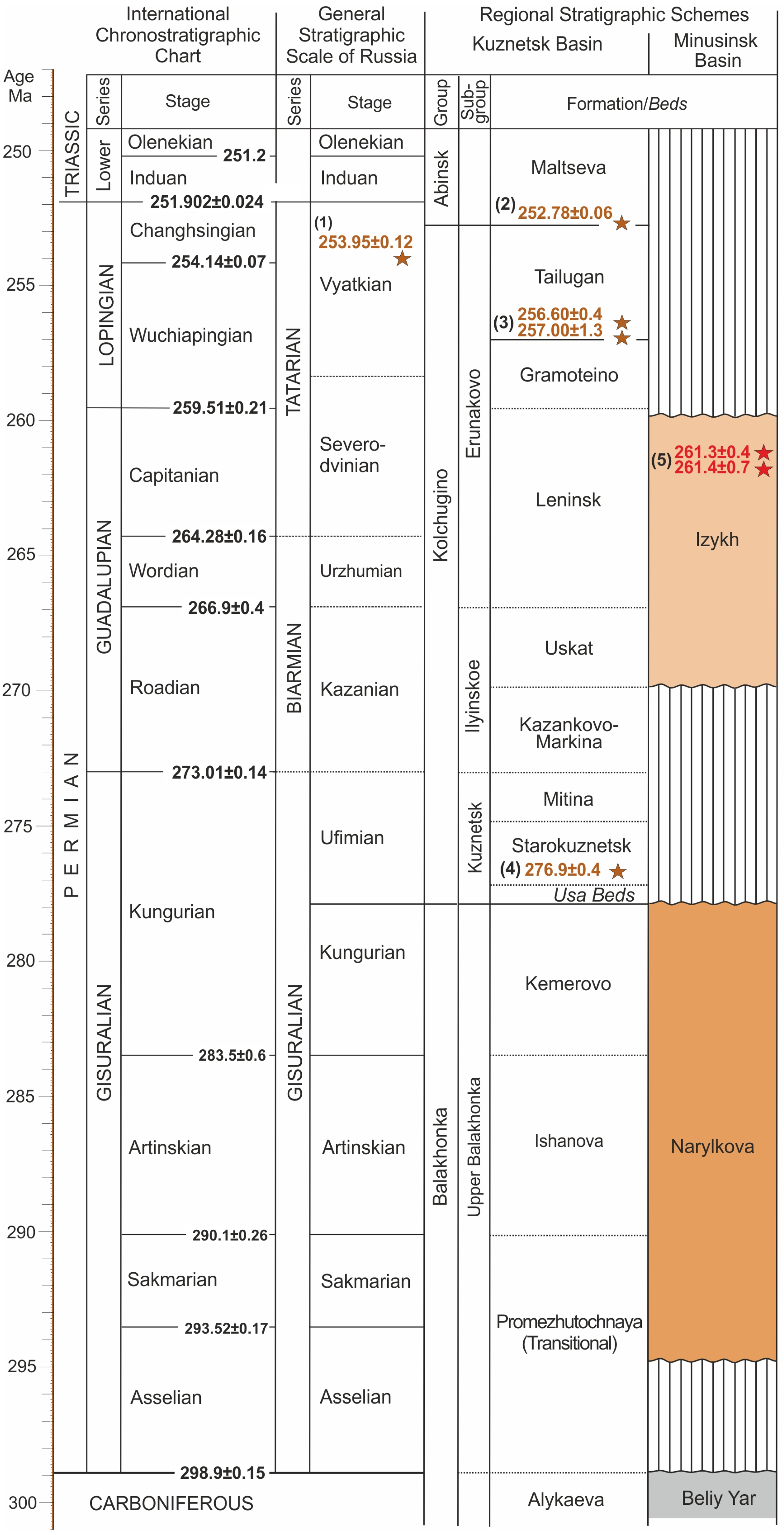
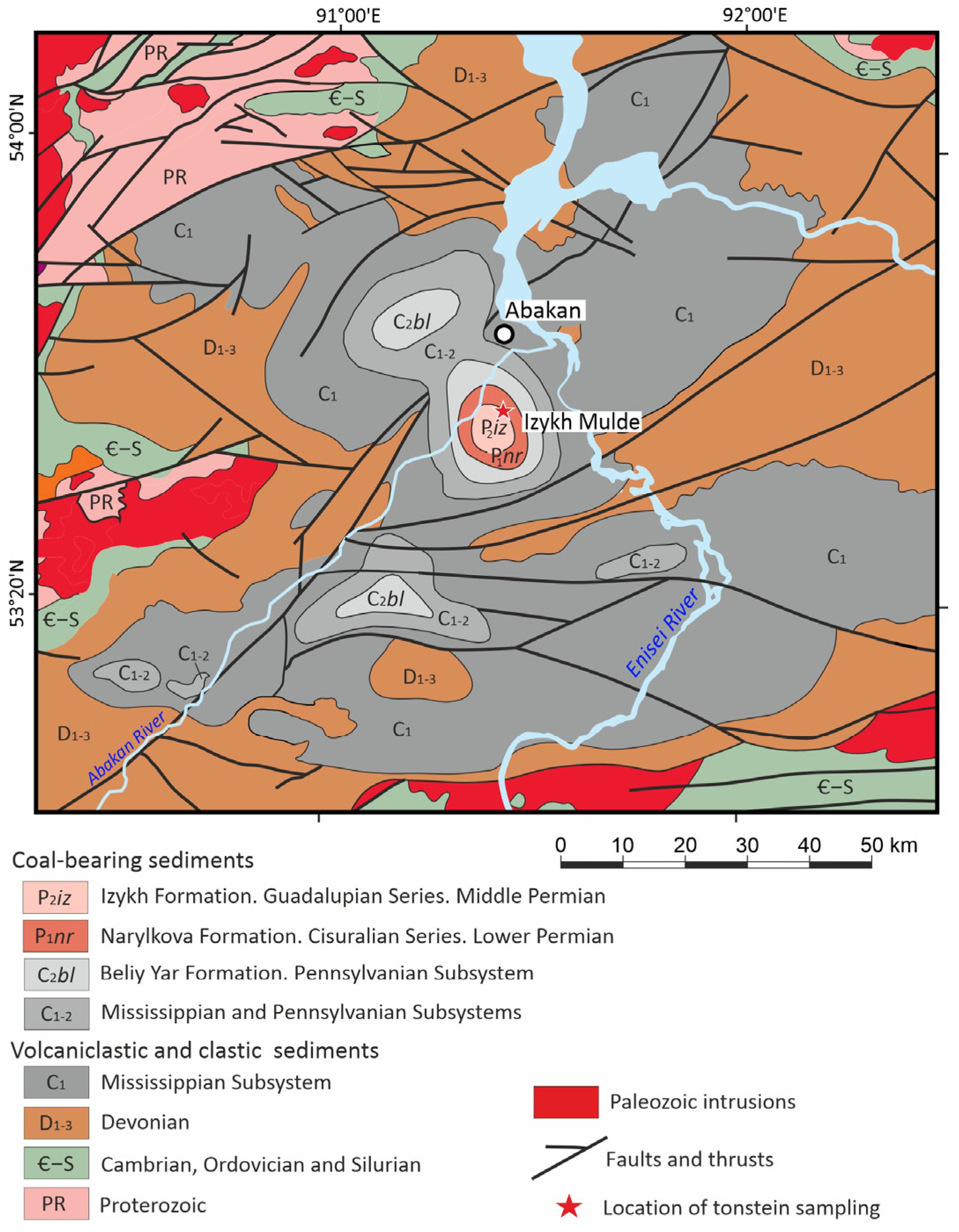
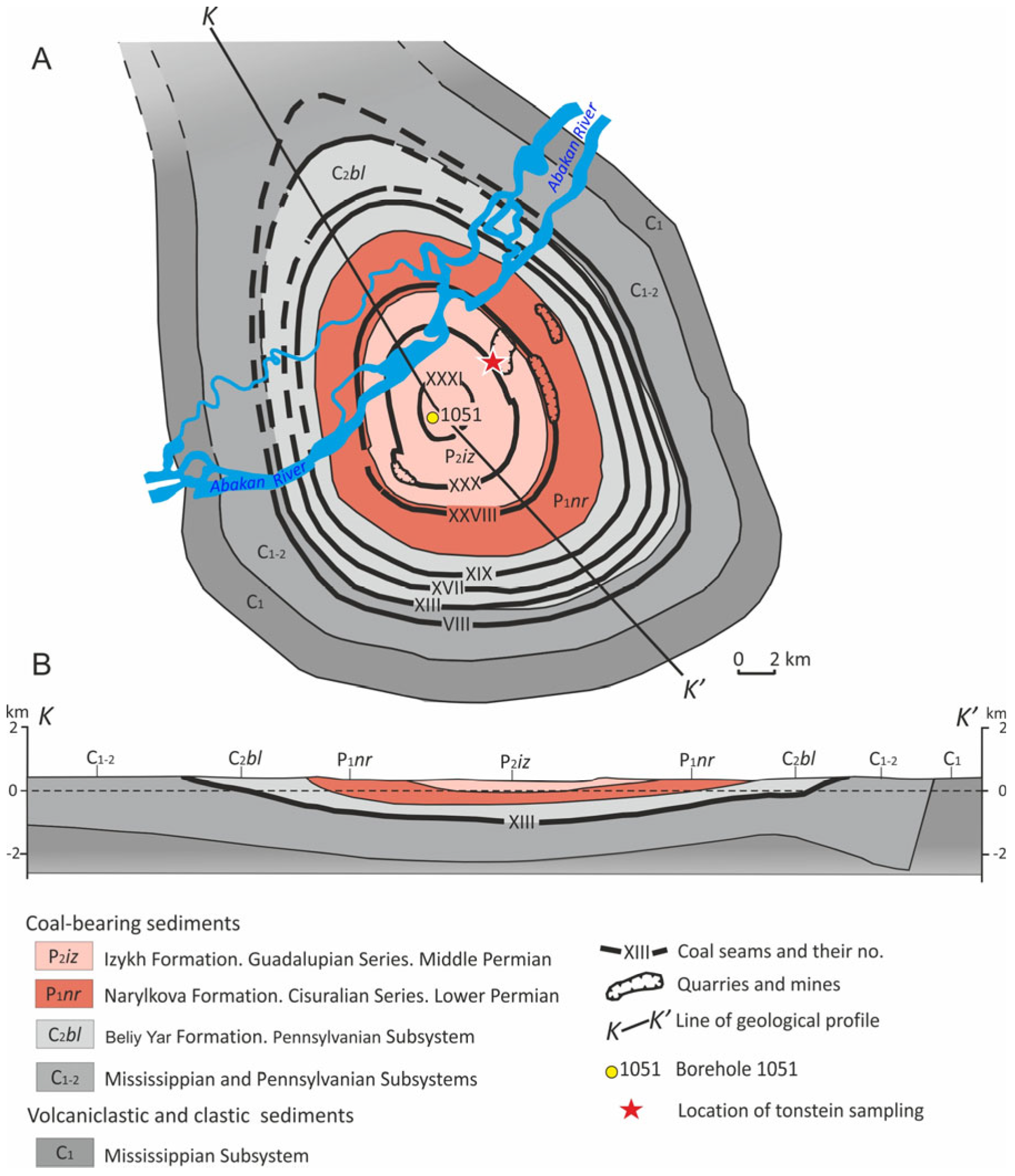
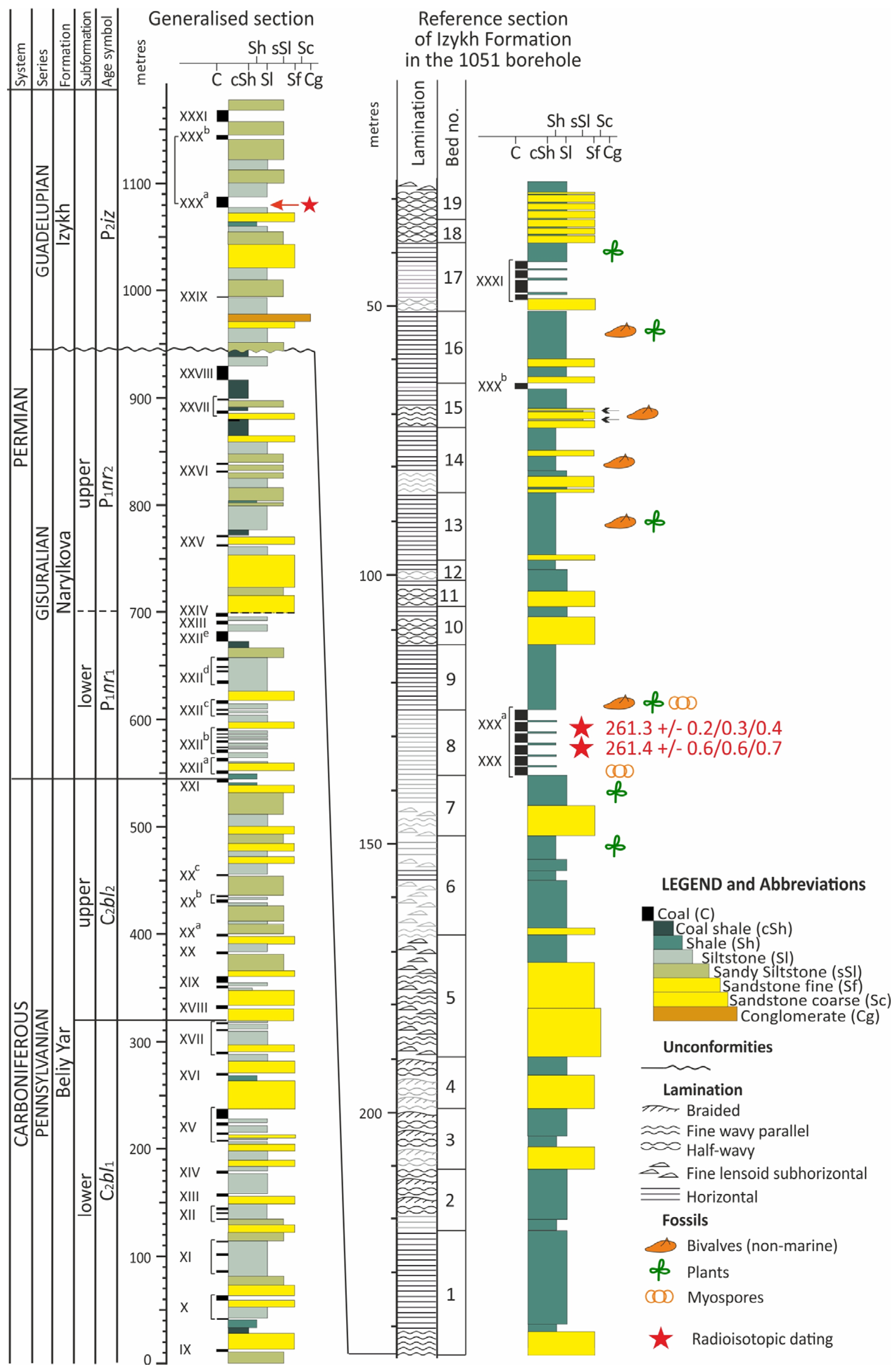

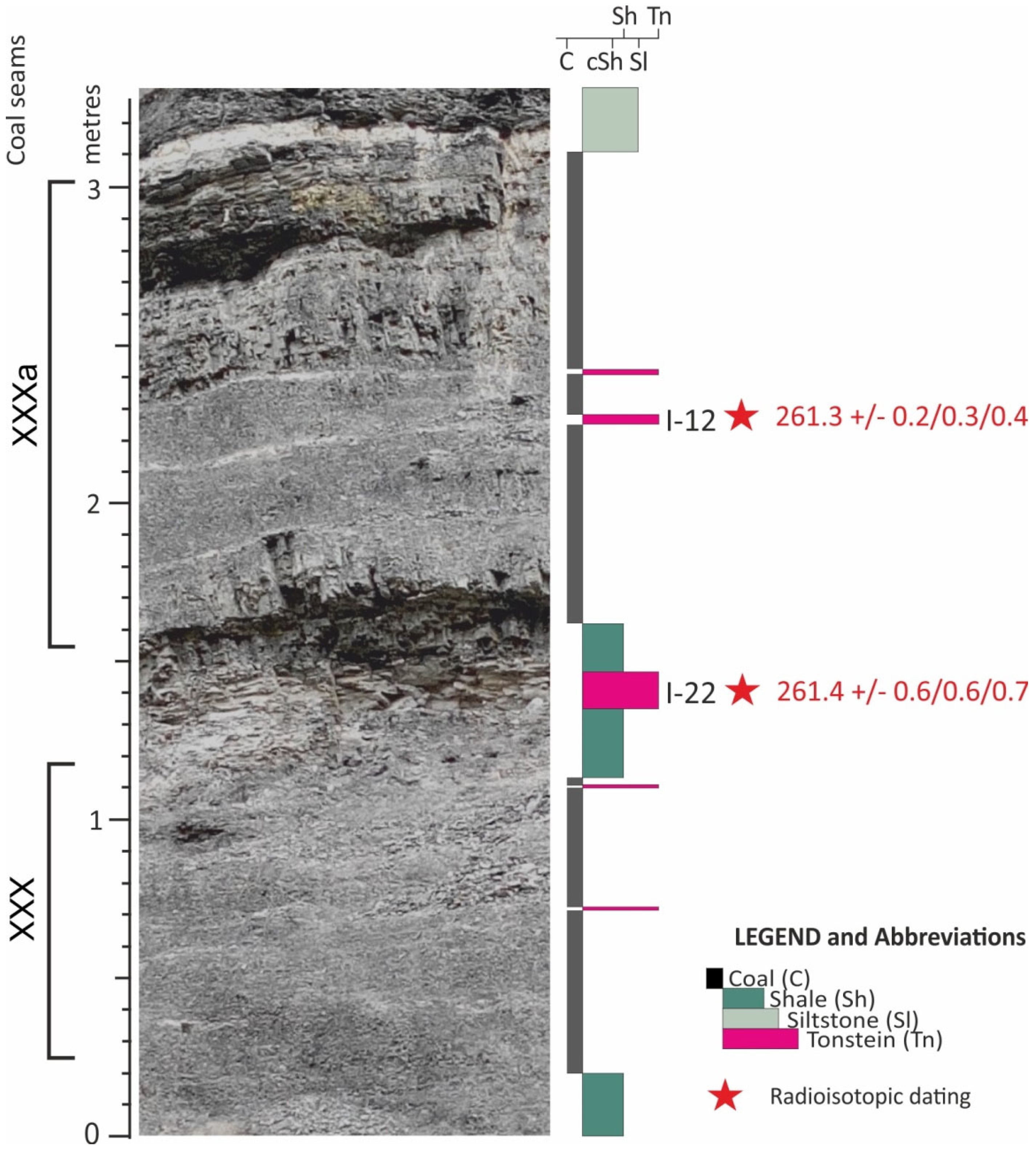

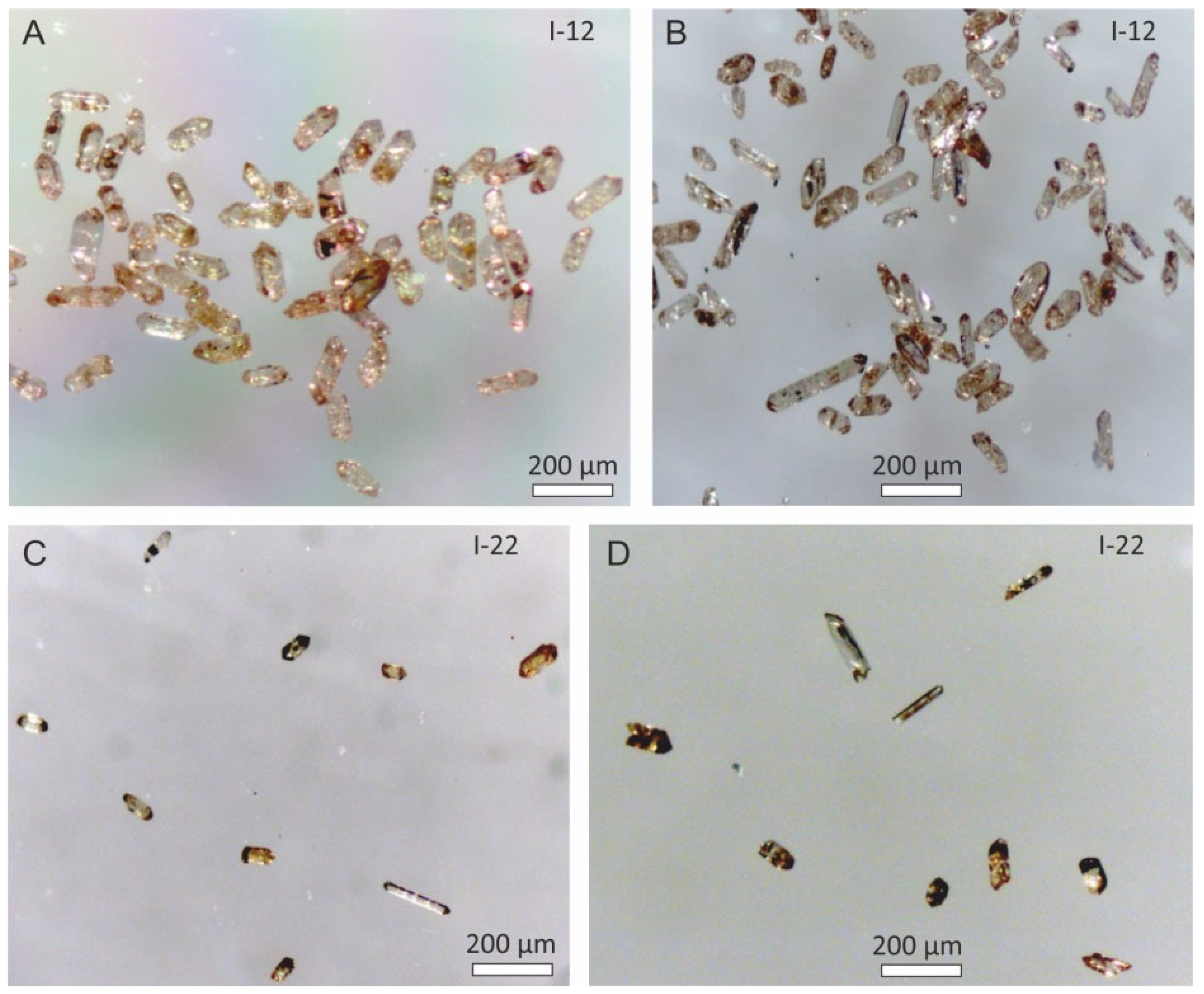

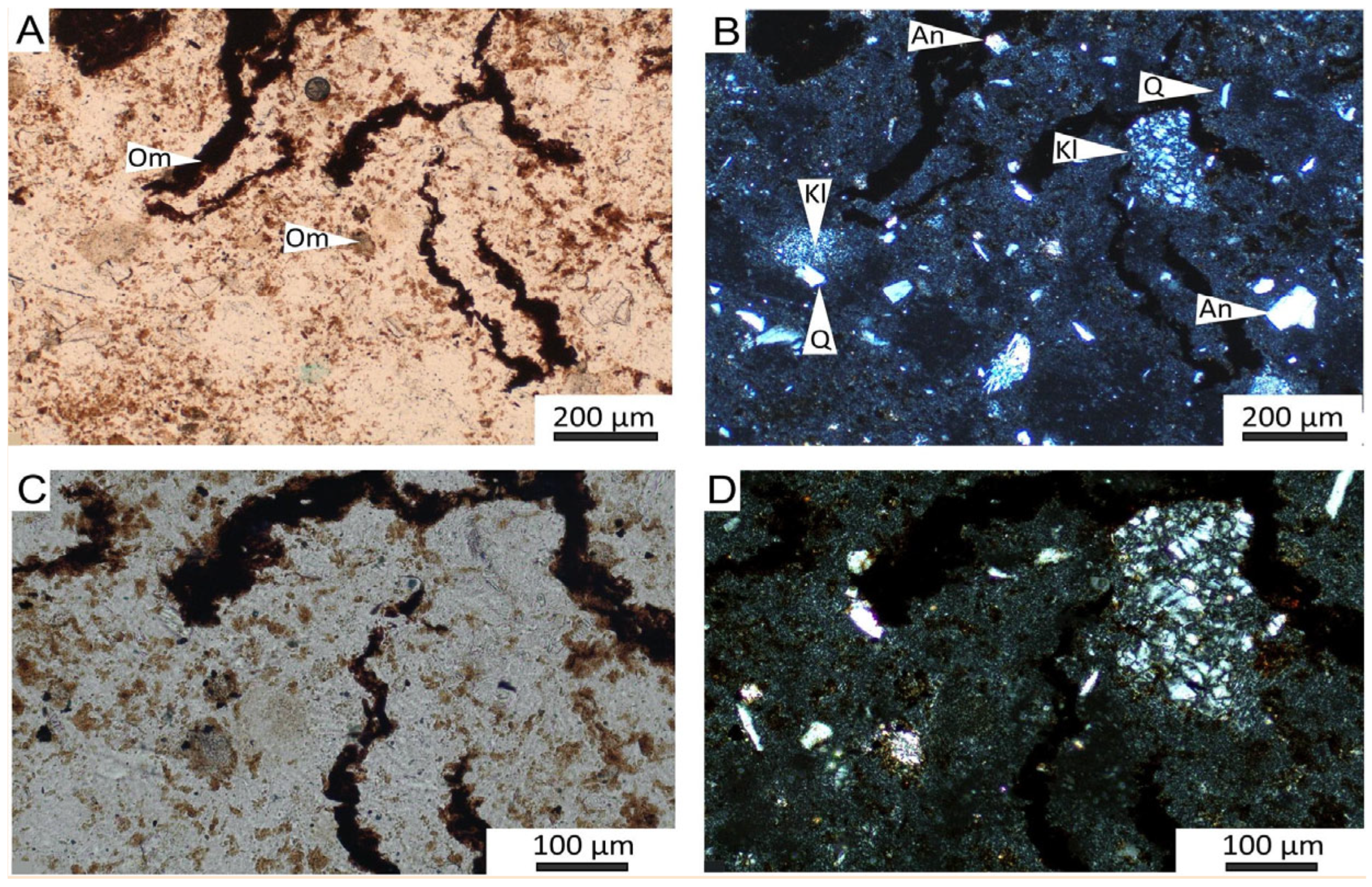

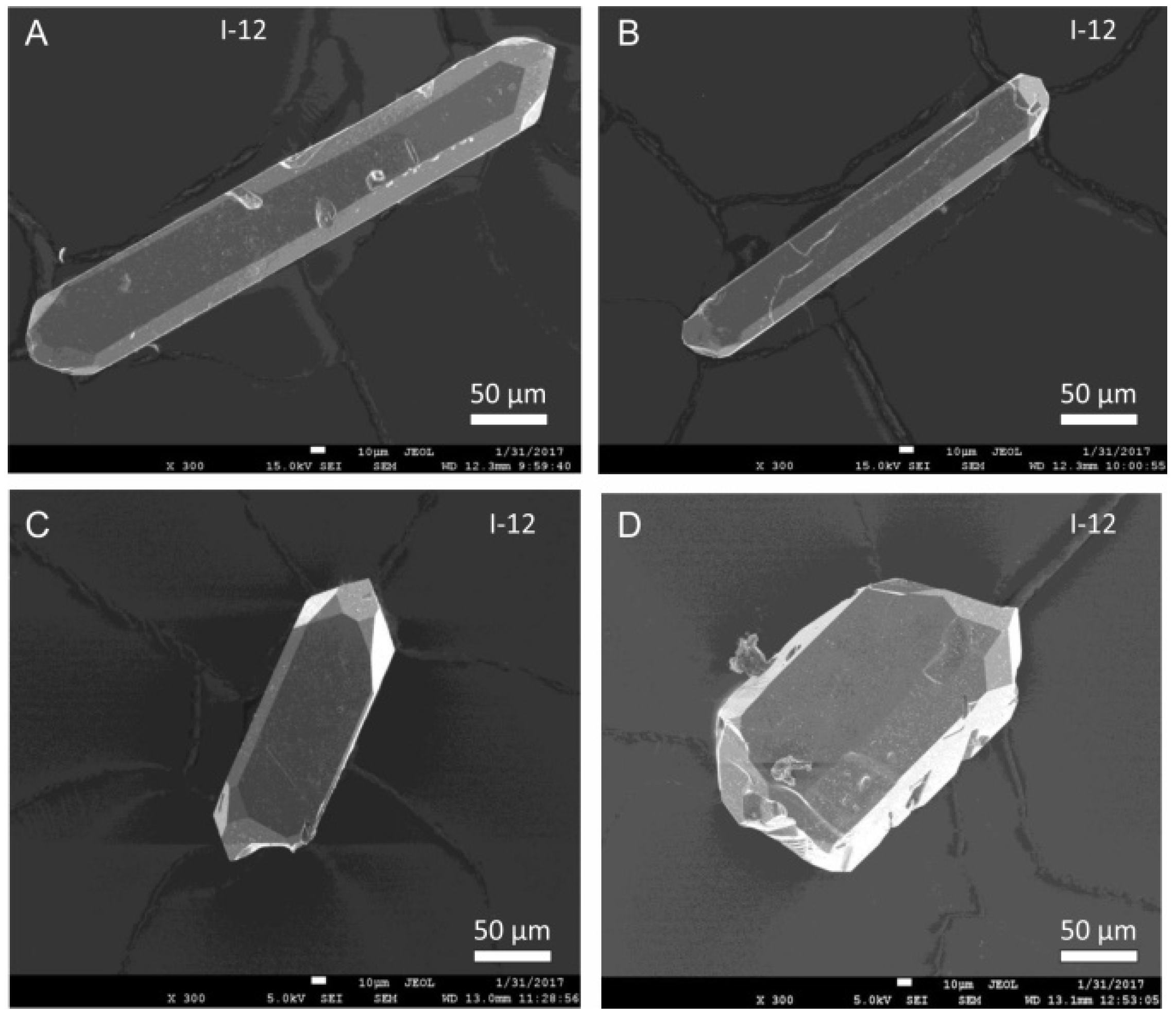
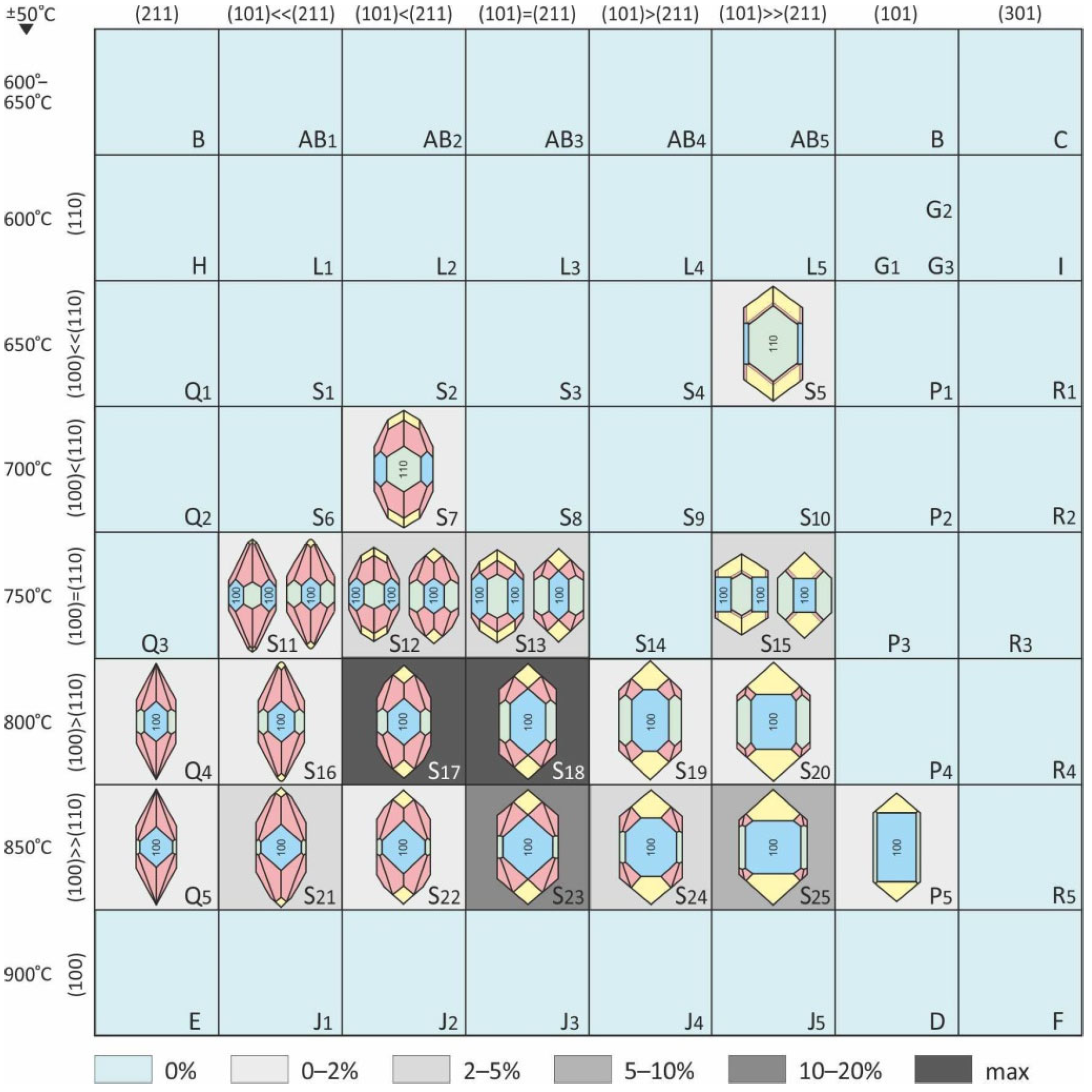
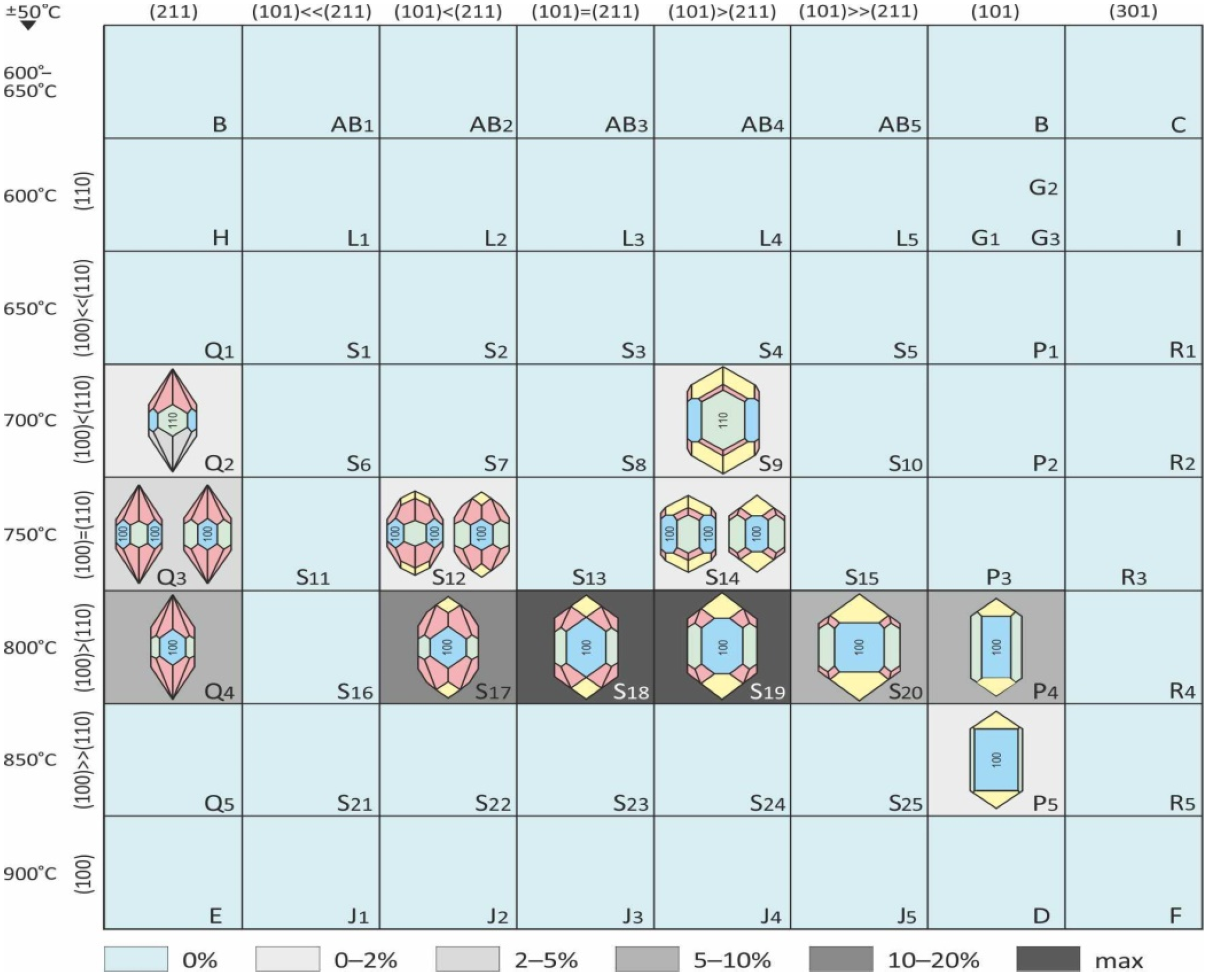

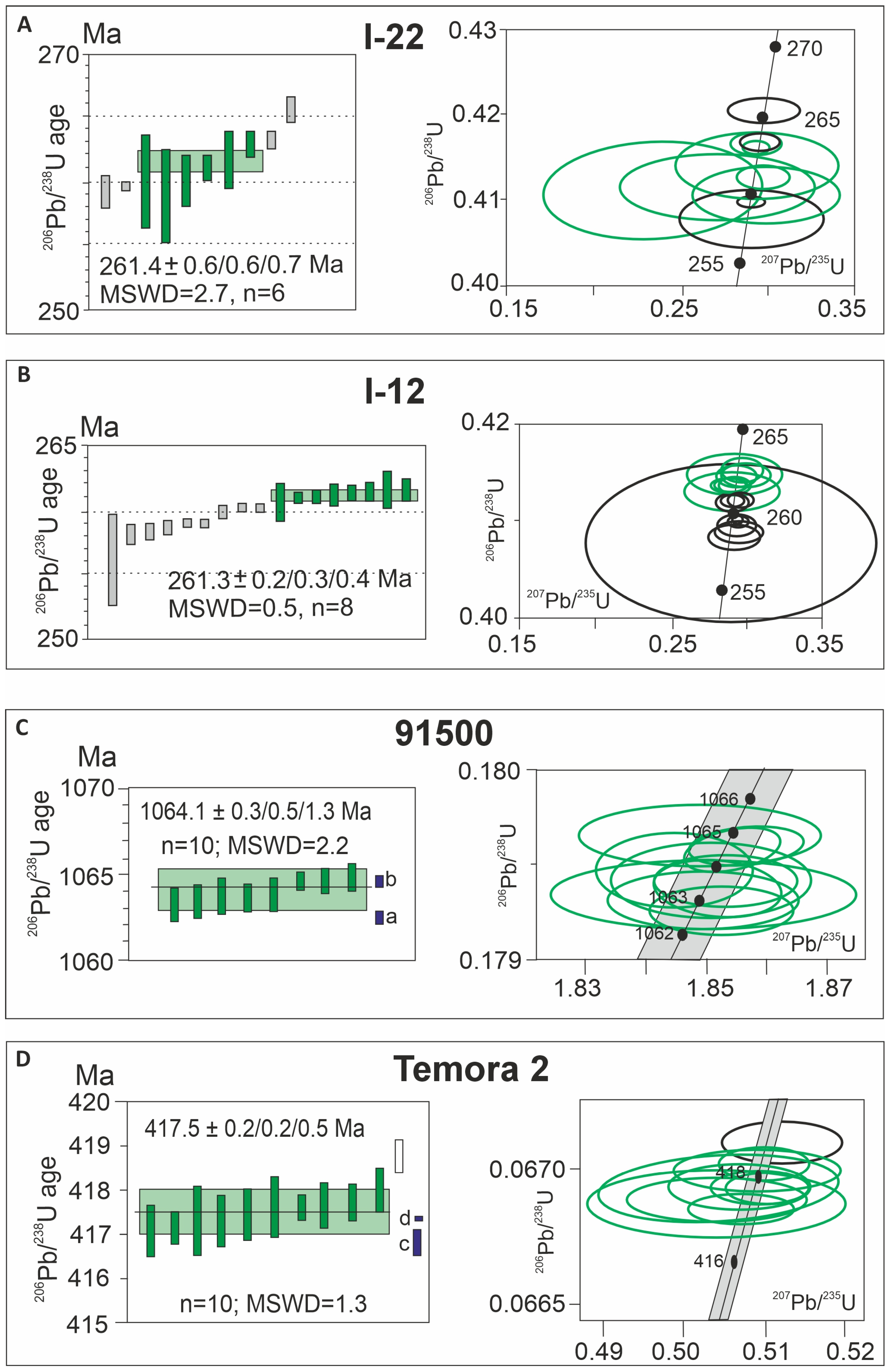
| Mineral | Tonstein I-12 | Tonstein I-22 |
|---|---|---|
| Kaolinite | 42.6 | 56.2 |
| Quartz | 35.0 | 22.9 |
| K-feldspar (sanidine and microcline) | 9.8 | 12.5 |
| Albite | 4.2 | 5.6 |
| Apatite | 11.7 | 2.7 |
| Total | 99.1 | 99.9 |
| Major Element Oxides (Weight %) | Tonstein I-12 | Tonstein I-22 | UCC | NASC |
|---|---|---|---|---|
| SiO2 | 34.7 | 49.8 | 66.6 | 64.8 |
| TiO2 | 0.59 | 0.65 | 0.64 | 0.70 |
| Al2O3 | 16.4 | 27.8 | 15.4 | 16.9 |
| Fe2O3 | 0.81 | 0.86 | 5.61 | 6.30 |
| MnO | 0.011 | 0.006 | 0.10 | 0.06 |
| CaO | 3.61 | 1.58 | 3.59 | 3.63 |
| MgO | 0.20 | 0.31 | 2.48 | 2.86 |
| K2O | 0.85 | 0.71 | 2.80 | 3.97 |
| Na2O | 0.18 | 0.37 | 3.27 | 1.14 |
| P2O5 | 2.16 | 0.88 | 0.15 | 0.13 |
| Loss on Ignition (LOI, %) | 35.6 | 13.6 | - | - |
| Total | 99.7 | 99.8 | 100.64 | 100.49 |
| SiO2/Al2O3 | 2.12 | 1.79 | 4.3 | 3.8 |
| TiO2/Al2O3 | 0.036 | 0.023 | 0.042 | 0.041 |
| Element | Tonstein I-12 | Tonstein I-22 | Sedimentary Rocks 1 | Upper Continental Crust (UCC) 2 | Acid Volcanic Rocks 3 | Coal Ashes 4 |
|---|---|---|---|---|---|---|
| Li | 68.2 | 20.7 | 33 | 21 | 26 | 66 |
| Be | 4.3 | 0.45 | 1.9 | 2.1 | 4 | 9.4 |
| Sc | 11.4 | 6.9 | 9.6 | 14 | 4.2 | 23 |
| V | 8.4 | 11.9 | 91 | 97 | 60 | 155 |
| Cr | 2.4 | 3.4 | 58 | 92 | 8.5 | 100 |
| Co | 1.3 | 1.7 | 14 | 17.3 | 4.8 | 32 |
| Ni | 21.9 | 92.2 | 37 | 47 | 8 | 76 |
| Cu | 68.6 | 57.5 | 31 | 28 | 15 | 92 |
| Zn | 100.4 | 55.7 | 43 | 67 | 35 | 140 |
| Ga | 20.8 | 36.2 | 12 | 17.5 | 26 | 33 |
| Ge | 9.2 | 14.9 | 1.4 | – | 1 | 15 |
| As | 14.9 | 10.8 | 7.6 | – | 4.3 | 47 |
| Se | 6.4 | 8.1 | 0.27 | – | 0.093 | 8.8 |
| Rb | 14.6 | 8.4 | 94 | 84 | 190 | 79 |
| Sr | 236 | 218 | 270 | 320 | 240 | 740 |
| Y | 81.2 | 39.2 | 29 | 21 | 24 | 51 |
| Zr | 94.8 | 115.3 | 170 | 193 | 110 | 210 |
| Nb | 7.1 | 4.6 | 7.6 | 12 | 26 | 20 |
| Mo | 1.4 | 1.2 | 1.5 | – | 3.4 | 14 |
| Cd | 0.3 | 0.2 | 0.8 | 0.09 | 0.3 | 1.2 |
| Sn | 2.1 | 3.0 | 2.9 | 2.1 | 3.5 | 6.4 |
| Sb | 0.1 | 0.70 | 1.2 | 0.4 | – | 6.3 |
| Cs | 0.6 | 0.9 | 7.7 | 4.9 | 10 | 6.6 |
| Ba | 445 | 231 | 410 | 628 | 480 | 940 |
| La | 35.6 | 88.1 | 32 | 31 | 31 | 69 |
| Ce | 76.9 | 169.8 | 52 | 63 | 58 | 130 |
| Pr | 8.7 | 16.7 | 6.8 | 7.1 | 10 | 20 |
| Nd | 35.5 | 62.0 | 24 | 27 | 27 | 67 |
| Sm | 7.9 | 10.8 | 5.5 | 4.70 | 5.2 | 13 |
| Eu | 1.8 | 1.6 | 0.94 | 1.0 | 1.5 | 2.5 |
| Gd | 8.6 | 9.8 | 4 | 4.0 | 5 | 16 |
| Tb | 1.3 | 1.4 | 0.69 | 0.70 | 0.82 | 2.1 |
| Dy | 8.8 | 7.4 | 3.6 | 3.90 | 6 | 14 |
| Ho | 2.1 | 1.4 | 0.92 | 0.83 | 1.7 | 4.0 |
| Er | 7.3 | 3.4 | 1.7 | 2.30 | 3.6 | 5.5 |
| Tm | 1.1 | 0.5 | 0.78 | 0.30 | 1 | 2.0 |
| Yb | 8.0 | 3.0 | 2.0 | 1.96 | 2.5 | 6.2 |
| Lu | 1.1 | 0.4 | 0.44 | 0.31 | 0.55 | 1.2 |
| Hf | 3.9 | 5.2 | 3.9 | 5.3 | 4.1 | 8.3 |
| Ta | 0.9 | 1.9 | 1.0 | 0.9 | 1.8 | 1.7 |
| W | 0.5 | 0.3 | 2.0 | – | 1.4 | 6.9 |
| Tl | 0.13 | 0.07 | 0.89 | 0.9 | 2.1 | 4.9 |
| Pb | 19.7 | 30.0 | 12 | 17 | 23 | 47 |
| Th | 12.3 | 31.9 | 7.7 | 10.5 | 13 | 21 |
| U | 3.8 | 7.1 | 3.4 | 2.7 | 4.5 | 16 |
| Th/U | 3.2 | 4.5 | 2.26 | 3.9 | 2.9 | 1.3 |
Disclaimer/Publisher’s Note: The statements, opinions and data contained in all publications are solely those of the individual author(s) and contributor(s) and not of MDPI and/or the editor(s). MDPI and/or the editor(s) disclaim responsibility for any injury to people or property resulting from any ideas, methods, instructions or products referred to in the content. |
© 2024 by the authors. Licensee MDPI, Basel, Switzerland. This article is an open access article distributed under the terms and conditions of the Creative Commons Attribution (CC BY) license (https://creativecommons.org/licenses/by/4.0/).
Share and Cite
Silantiev, V.V.; Arbuzov, S.I.; Tichomirowa, M.; Käßner, A.; Izmailova, A.K.; Ilenok, S.S.; Soktoev, B.R.; Nurgalieva, N.G.; Gutak, Y.M.; Felker, A.S.; et al. First U-Pb (CA-ID-TIMS) Dating of the Uppermost Permian Coal Interval in the Minusinsk Coal Basin (Siberia, Russia) Using Zircon Grains from Volcanic Ashfalls. Minerals 2024, 14, 982. https://doi.org/10.3390/min14100982
Silantiev VV, Arbuzov SI, Tichomirowa M, Käßner A, Izmailova AK, Ilenok SS, Soktoev BR, Nurgalieva NG, Gutak YM, Felker AS, et al. First U-Pb (CA-ID-TIMS) Dating of the Uppermost Permian Coal Interval in the Minusinsk Coal Basin (Siberia, Russia) Using Zircon Grains from Volcanic Ashfalls. Minerals. 2024; 14(10):982. https://doi.org/10.3390/min14100982
Chicago/Turabian StyleSilantiev, Vladimir V., Sergey I. Arbuzov, Marion Tichomirowa, Alexandra Käßner, Alsu Kh. Izmailova, Sergey S. Ilenok, Bulat R. Soktoev, Nouria G. Nurgalieva, Yaroslav M. Gutak, Anastasia S. Felker, and et al. 2024. "First U-Pb (CA-ID-TIMS) Dating of the Uppermost Permian Coal Interval in the Minusinsk Coal Basin (Siberia, Russia) Using Zircon Grains from Volcanic Ashfalls" Minerals 14, no. 10: 982. https://doi.org/10.3390/min14100982
APA StyleSilantiev, V. V., Arbuzov, S. I., Tichomirowa, M., Käßner, A., Izmailova, A. K., Ilenok, S. S., Soktoev, B. R., Nurgalieva, N. G., Gutak, Y. M., Felker, A. S., Porokhovnichenko, L. G., Eliseev, N. A., Zharinova, V. V., Nurieva, E. M., & Urazaeva, M. N. (2024). First U-Pb (CA-ID-TIMS) Dating of the Uppermost Permian Coal Interval in the Minusinsk Coal Basin (Siberia, Russia) Using Zircon Grains from Volcanic Ashfalls. Minerals, 14(10), 982. https://doi.org/10.3390/min14100982








